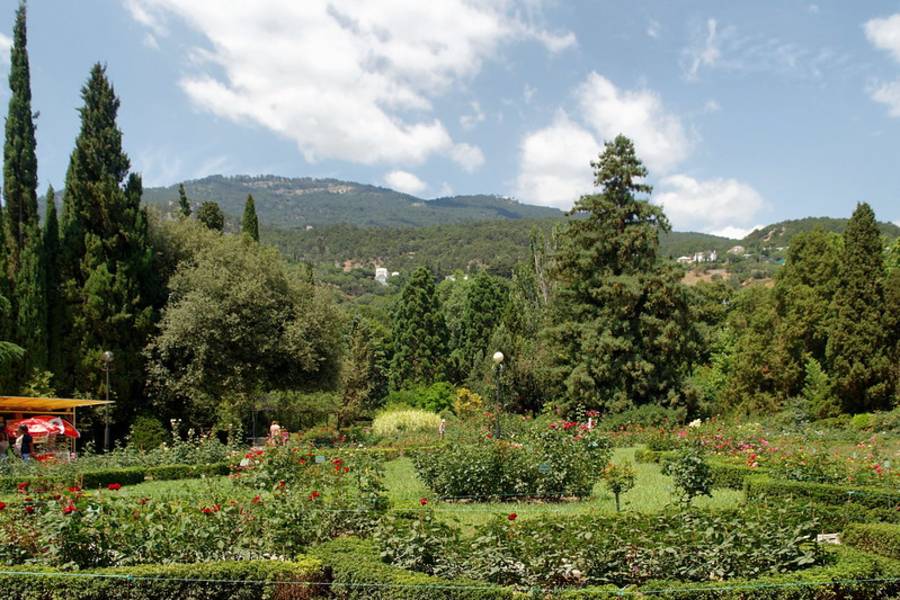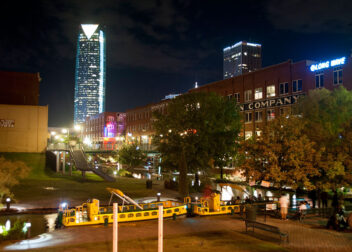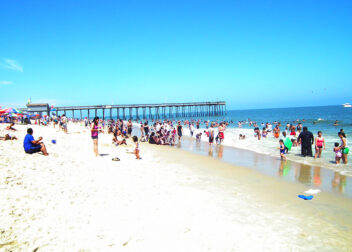Nikitsky Botanical Garden Vacation Spot
Town Nikita located between Yalta and Gurzuf. Nikitskayayaila – one of the forestry of Yalta mountain forest reserve. On the slopes of the plateau originated many mountain streams. Intense aromas of pine forest air plateau, descending to the coast, makes the climate salubrious. Imagine its flavor on the plateau itself!
In 1984, Nikita established Research Complex on the protection of the geological environment of Crimea. It is carried out a systematic analysis of stocks and the dynamics of underground waters of the peninsula, is tracked for landslides, is mathematical models of landslide areas, solving many other problems of environmental protection. Vicinity of the environmental complex is a monument of nature – Nikita crack – vividly illustrates the enormous power of earthly forces.
But most of all the village is famous for its famous botanical garden. In 1812, in Europe, there were two important developments. Emperor Napoleon had decided to conquer India via Russia, and His Imperial Majesty Alexander I at the request of the governor-general of the Novorossiysk Territory of the Duke of Richelieu signed in St. Petersburg, a decree establishing the “treasury of the Tauride Garden”. Fulfilling an imperial command, Christian Christianovich Steven (1781-1857) was “saving plan, the botanical garden on the southern coast of Tauris, under village Nikita”, which was supposed to solve three problems worthy of Crimea: to collect all the plants of the world that can grow here, to acclimatize them to distribute if possible, on the peninsula and beyond, as well as break orchards and vineyards.
Almost two centuries have passed since then. The entire southern coast of Crimea became a living monument of research, successes, and insights, and most importantly – the long, painstaking work of many generations of botanists. Thanks to scientists Nikita Botanical Gardens neighbors from the Caucasus have the ability to grow their lemons, oranges, and tangerines. It was in the garden of the Crimean Nikita Botany in 1860 and acclimatized to define a unique cold resistance of wild lemon trifoliata, which grafted cuttings of different varieties of the above citrus.
What’s citrus. If anyone ever come away with the South Coast all the plants, seedlings were grown in Nikita, the species composition of the Crimean flora would have decreased by half, from the above in any case should not be inferred that there is no need to visit the Nikita Botanical Garden on the grounds that plants collected here, you can see in Yalta, Miskhor of Alupka. The only reason that you can avoid getting acquainted with Nikitsky garden – a malicious desire to deprive yourself of an unforgettable experience.
It is impossible to describe in a few lines the treasures of this living museum of Nature! Some were just fine vines with bright colors, called clematis are 200 forms, only of roses, filling Nikita aura, there are about two thousand varieties. The collection of garden varieties are from different countries, but we are proud to see that in no way inferior to them by local breeders sort: girlish blush, Coral Beauty, Yalta Souvenir, Clementine … The latter received an honorary diploma at the International Exhibition of roses in Rome.
On a small tour itinerary, you can see plants from all over the world and create by a talented landscape architect.
Astonishing imagination of a rich collection of conifers. In the “Guinness Book of Records” is always present sequoia, mammoth tree. In Nikitsky’s garden, you can see several species of these giant plants. Tridtsatimetrovye Sequoia dendrons – even babies, they do not, and 150 years, but the diameter of their trunks is equal to 170 cm and the height exceeds 35 meters. At home in California, this tree grows to 100 m or more, his age is 2-3 thousand years. The name of the tree comes from the name of the famous leader of the tribe of Iroquois Sequoia – the creator of the first Indian writing.
Another type of mammoth tree – Sequoia evergreen has very beautiful reddish wood, which is why in America it is often referred to as mahogany.
In 40-in. XX century. Japanese palaeobotanist Miki by foot plant in Tertiary sediments found that once existed on Earth plant, which he called Metasequoia. It turned out that the relict tree is not dead, but still alive in the highlands of China and in the Nikita Botanical Gardens.
In the preglacial period with redwoods survived to this day yew berry – the oldest plants on Earth. In the collection of gardens, there are 4 types and 12 forms of cedars. At the end of the XIX century. in the Atlas Mountains in northwestern Africa on one of the trees was discovered a “weeping” branch. Inoculated cuttings from her and gave rise to the unique tree with bluish needles. Regal century-old grove of magnificent Himalayan cedars – one of the most beautiful trees on the planet. No wonder, in Sanskrit, the old Indian language, it is called Deodar – “heavenly gift”. Cedars of Lebanon have decorated not only the flag of his homeland but also the landscapes of the Nikitskiy garden. From the earliest times and throughout the Lebanese cedar valued very highly. From his wood built temples, ships, sarcophagi. From the wood of this tree was built one of the seven wonders of the world – the Temple of Artemis at Ephesus (550 BC. E.). River cedar with red-brown bark have wood used, even for underwater structures.
Compete with cedars, attracting the attention of visitors, pine. There are pine and Aleppo, named after the town Aleppo in northern Syria. Crohn’s recent lean toward the south, so it is often called a tree-compass. Unusual rare pine with long needles dangling, named in honor of the legendary leader of the Aztec Montezuma.
Very beautiful Numidian and Spanish fir, spruce, Himalayan with long needles to “weeping” branches and cypress Guadalupe, which is easily determined by the peeling blue needles and a copper-bronze bark, which was awarded the title of “bronze tree.” In the collection of gardens, there are 47 species and forms of cypress.
Of course, in the garden waiting for you not only conifers. Here you can see the amazing ginkgo, which appeared on Earth about 150 million years ago. “Living fossil” called this tree the great Charles Darwin.
As we know, the devil fears holy water and hence grows a frankincense tree – the charity case. Maybe that’s why in the garden, one can count about 20 species that form Boswellia – so it is called the East African tree scientifically. Frankincense is obtained from incisions in the roots of several species of this tree.
Many parks adorn the Southern coast oleander bushes. This genus of the family Apocynaceae includes three species native to Mediterranean and subtropical Asia. Preparations from the leaves of oleander are used for the treatment of vascular diseases. The collection of garden has more than 25 forms of this beautiful plant in every respect.
No less curious indigenous Crimean trees. In the garden are Nikitsky oak fluffy, which is more than 500 years, juniper, strawberry tree, and many other endemic species for the Crimea.
How do tell about all the diversity of flora Nikita? Fans waving palm trees. Beautiful avenue of oaks stone, with wood so dense that it sinks in water. Rustling leaves, bamboo that is growing day by 40 cm and 12 barrels zelkovagrabolistnoy fused and intertwined in one – this is a biological feature of this tree.
In the old earthen terraces tease visitors with pomegranates, persimmon, feijoa, jujube, figs, and olives. The collection of fruit trees in Nikita Botanical Gardens, as they say, botany – pomo logic collection “, dates back to 1817 when she already has 250 varieties. Today, several thousand varieties, a collection of apricot, plum, quince, pomegranates, figs, olives, almonds, and walnuts, created by scientists, are the most complete in Eastern Europe. From 1826 collected an extensive collection of grape varieties. Nikita Botanical Garden has created a collection of essential oil crops, from which originated this branch of agriculture of Crimea, which has been developing for more than 75 years.
Nikita garden – a masterpiece of landscape art. Rockslide park cleverly planted cactus yukkami, agave. In pools among the reeds and cattails blossom water lily and lotus Caspian.
Typically, tours end at the bent willow of Babylon, which, like all the “weeping” willow, inclined to melancholy. Maybe she just spread easily sorrow of thousands of people, sorry to part with a place where people try to imitate the righteous Noah, who has taken with him into the ark “every creature on a pair.” Perhaps during his voyage to the Ararat, he stayed in Nikita?
However, as we know, everything was different, which means that each of us has the opportunity, passing along the path between the sparkling turquoise swimming pool and an administration building, where the available scientific library and management, for a moment to stop at the bust of Academician X. X. Steven and say to himself, giving him the duty of remembrance, and many other obscure outside the academic world, researchers and breeders, theorists and practitioners: “Thank you. You have made our lives a little richer and more beautiful.”



